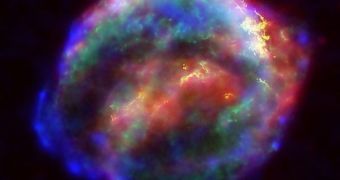Three applied mathematicians at the US Department of Energy's (DOE) Lawrence Berkeley National Laboratory (Berkeley Lab), and two astrophysicists have recently created the first computer simulations of the final hours of white dwarf stars, right before they explode into Type Ia supernovae. The full-star-simulation moments preceding the largest thermonuclear explosions in the Universe will provide experts with answers to some of the mysteries surrounding the phenomena that take place when these massive stellar explosions occur. Details of the model are published in the October issue of the Astrophysical Journal.
The new model was made by Berkeley Lab Computational Research Division experts Ann Almgren, John Bell and Andy Nonaka, who worked together with colleagues Mike Zingale, from the Stony Brook University, and Stan Woosley, from the University of California in Santa Cruz (UCSC). The simulation essentially maps the entirety of the convection processes that take place inside a white dwarf in the last few hours of its life, and it does so in 3D. Experts can shift the perspective, and can observe the phenomena from anywhere within the star they choose to. In charge of funding the new study was the DOE Office of Science.
“We're trying to understand something very fundamental, which is how these stars blow up, but it has implications for the fate of the Universe,” Almgren explains. Supernova explosions, especially Type Ia ones, are used for very complex measurements of the Cosmos, and play a huge role in determining the speed at which the Universe expands. Astronomers started using them as reference points because almost all seen explosions resembled each other considerably. The main issue is that scientists never knew how these stars exploded, and previous models had not been very helpful.
“Few have tackled this problem before because it was considered intractable. We needed to simulate the conditions for hours, not just a few seconds. We are now doing calculations that weren't possible before,” Almgren adds. MAESTRO is the team's answer to the challenge. Devised over a period of three years, the code simulates the flow of mass and heat throughout the star over time. It can only be run on supercomputers with a lot of processing power, as the processes it models are extremely complex. The Oak Ridge Leadership Computing Facility's Cray XT4 'Jaguar' supercomputer was used for the team's compilations.
The team could use the massive machine via allocation under DOE's Innovative and Novel Computational Impact on Theory and Experiment (INCITE) program. “The INCITE allocation on Jaguar was crucial in enabling the successful runs leading to these groundbreaking results. And the continuing support of the Department of Energy Office of Science is critical to advancing our research,” Woosley, who is also the SciDAC supernova project leader, concludes. The initiative had encouraged successful collaborations between applied mathematicians and astrophysicists before.

 14 DAY TRIAL //
14 DAY TRIAL //